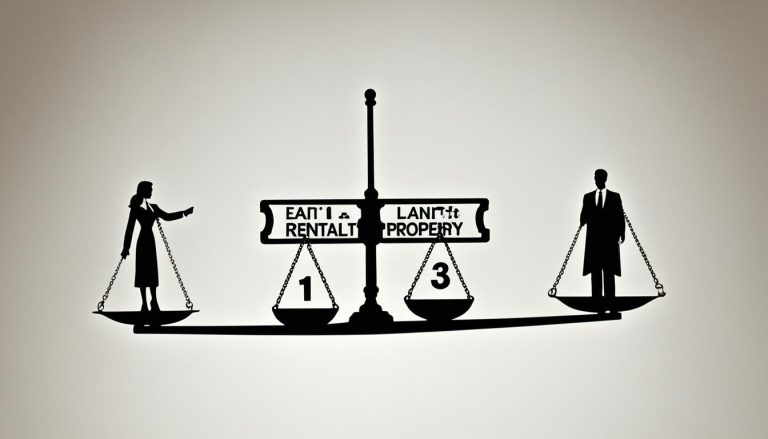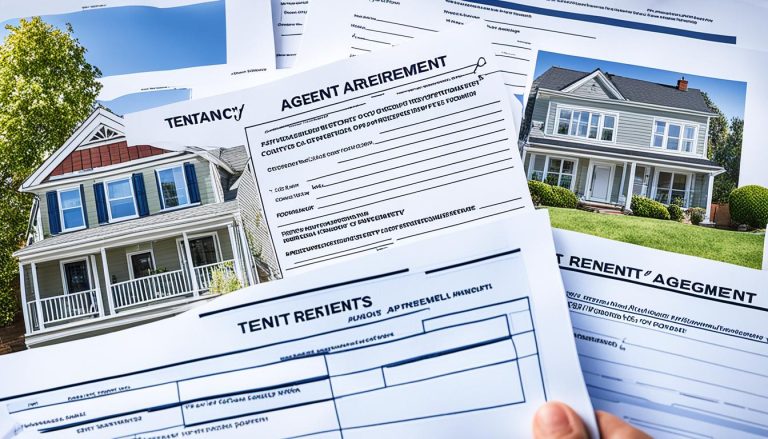A 12-month break clause in a 24-month contract offers a provision allowing either the tenant or landlord to terminate the rental agreement after 12 months, given certain conditions such as notice periods are met. This type of clause is not mandatory but offers flexibility for both parties involved. Before exercising the break clause, it’s crucial that rent payments are current. Formal termination of the tenancy agreement also requires the tenant to vacate the property completely.
By integrating a 12-month break clause in a 24-month contract, tenants and landlords can mitigate the rigidities of long-term commitments. Understanding the benefits and obligations connected to such clauses ensures smoother transitions and clear-cut rental agreement termination options.
Understanding the Concept of a Break Clause
A break clause is a crucial element in tenancy agreements, particularly in the UK. This clause permits either the tenant or the landlord to terminate the lease prematurely, offering a gateway to end the contract under specific conditions. The inclusion of a break clause in a 24 month tenancy ensures a layer of contract flexibility for both parties amidst changing circumstances.
Definition of a Break Clause
A break clause is a predetermined provision in a tenancy agreement that allows for early termination. It can be invoked by either the tenant or the landlord, provided that all stipulated conditions are fulfilled. For instance, a break clause example might dictate that a two-month notice period is mandatory before the lease can be concluded. These conditions must be clearly stated in the rental agreement to avoid potential disputes later on.
Purpose of a Break Clause
The primary aim of incorporating a break clause in a 24 month tenancy is to inject a degree of contract flexibility. This provision accommodates unforeseen events or changes in circumstances by granting an avenue for early lease termination. For tenants, this might mean relocating for a new job opportunity without the worry of long-term contractual obligations. For landlords, it provides a mechanism to reclaim possession of their property sooner if necessary. Clearly defined terms, such as notice periods and property condition upon return, are essential to preserve the integrity and functionality of the break clause.
How a Break Clause Functions in a Tenancy Alternative?
Implementing a legal break clause in long-term lease agreements can provide significant flexibility for both tenants and landlords. Understanding the mechanics and common terms associated with these clauses is crucial for a smooth execution.

Mechanics of Implementing a Break Clause
The enactment of a break clause requires precise adherence to various conditions outlined within the tenancy agreement. Most importantly, landlords and tenants must mutually agree upon specific notice periods and methods of communication. Common practice dictates a notice period of around two months, although this can vary. Written notices must be clear and conform to the pre-agreed format, which may include the option of electronic communication.
Common Terms and Conditions
Key terms and conditions of a break clause include the method by which notice is given and the state of the property at the termination point. To facilitate an exit clause in contract agreements, it is essential that all parties understand their responsibilities, such as settling any outstanding payments and ensuring the property is returned in an acceptable condition. These early termination options must be clearly delineated within the tenancy contract to avoid disputes and ensure lawful exercise.
Benefits of Having a Break Clause
A break clause offers an array of benefits, notably by integrating flexibility within rental agreement terms. It serves as an essential tool for both tenants and landlords, providing an escape route if unforeseen circumstances arise.
For tenants, having well-defined early termination rights in a rental contract can alleviate concerns about long-term commitments. This provision allows them to adjust their living arrangements without enduring financial penalties, should their personal or professional conditions shift unexpectedly.
Landlords also gain from the inclusion of a break clause, as it helps mitigate the risks associated with tenant abandonment. By permitting a structured early termination process, they maintain control over the property and can plan for future rentals without the added burden of sudden vacancies.
Furthermore, addressing and negotiating unfair break clauses in tenancy agreements ensures both parties understand their roles and responsibilities, fostering a transparent and respectful rental relationship. This mutual understanding invariably leads to fewer disputes and a smoother termination process when it becomes necessary to enact the break clause.
Overall, break clauses are vital components in rental agreements, ensuring both tenants and landlords are protected and have clear pathways to address changing life circumstances.
Break Clause Example in a Tenancy Agreement
Break clauses are essential elements in tenancy agreements, providing both landlords and tenants with flexibility. Real-world scenarios often necessitate such clauses, ensuring that parties can adapt to changing circumstances such as job relocation or financial changes.

Real-World Scenarios
Consider a tenant who receives a sudden job offer in a different city and needs to relocate quickly. A break clause in the rental agreement terms allows for the lease agreement termination without incurring penalties, provided the notice period is respected. Similarly, a landlord might need to sell the property unexpectedly and would benefit from the early termination rights in the rental contract.
Explanation of a Sample Break Clause
A typical break clause stipulates that after a specified period, either party can terminate the lease with two months’ notice. This provides clear and predefined conditions for ending the tenancy, ensuring that both parties are aware of their rights and obligations. By incorporating such rental agreement terms, both tenants and landlords can manage the lease agreement termination smoothly and fairly.
Legal Aspects of Break Clauses in the UK
The legal framework surrounding rental contract break clauses in the UK requires careful attention to ensure they are equitable for both landlords and tenants. Central to this is compliance with the Housing Act 1988, which stipulates that any break clause must preserve a balance of rights.
In order to facilitate a lawful legal contract termination, the break clause must be explicitly outlined within the rental agreement, detailing the notice period and conditions under which it can be enacted. This clarity helps prevent disputes that may arise from ambiguities in the terms.
Both parties must also adhere to the specified procedures when exercising the break clause, including providing the required notice in writing. Failure to do so can lead to complications, such as legal disputes over unpaid rent and possession of the property.
Moreover, ensuring that the rental agreement termination options embedded in the contract are reasonable and transparent is crucial for protecting the interests of both tenants and landlords. This approach mitigates the risk of contentious exits and fosters smoother terminations of tenancy agreements.
An equitable rental contract break clause not only provides flexibility but also safeguards against potential conflicts, making it vital for all involved to understand their rights and obligations under the terms of the agreement.
12 Month Break Clause in 24 Month Contract
A 12-month break clause within a 24-month contract allows tenants or landlords to end the tenancy after the first year, given that notice is properly served. It significantly differs from other break clauses, mainly in its timing and specific conditions.
How It Differs from Other Break Clauses?
The principal distinction between a 12-month break clause in a 24-month contract and other break clauses lies in its activation period. While certain agreements may offer multiple opportunities to break the lease, typically at six months or quarterly intervals, the 12-month break clause provides a clear, singular midpoint for reassessment. This can offer additional security, as the exact timeframe for potential contract termination is known and predictable. Furthermore, adherence to a structured notice period and compliance with lease conditions remain essential to avoid an unfair break clause in tenancy agreement situations.
Implications for Both Parties
The implications of a 12-month break clause in a 24-month contract significantly affect both tenants and landlords. For tenants, this clause offers an essential escape route, empowering them with rental agreement termination options should their circumstances change – whether due to job relocation, financial strain, or personal reasons. On the other hand, landlords benefit from the flexibility to rethink their property portfolio management strategy after the first year. The notice period, often set at two months, ensures continuity of rent payments while transition arrangements are made.
Moreover, it is crucial for both parties to meticulously observe the required notice protocols to ensure a smooth transition. Missteps could lead to disputes, additional costs, or even legal action, emphasising the necessity of understanding and fulfilling the obligations under the break clause. Ensuring the property is returned in the pre-agreed condition further ensures compliance and avoids claims for damages.
| Aspect | 12 Month Break Clause | Other Break Clauses |
|---|---|---|
| Activation Period | After 12 months | Variable (e.g., at 6 months, 9 months) |
| Notice Period | Typically 2 months | Varies (commonly 2-3 months) |
| Flexibility | Fixed midpoint allows predictable planning | Multiple intervals provide varied options |
| Potential Issues | Strict compliance required to avoid disputes | Complexity in managing multiple break points |
Common Pitfalls with Break Clauses
One of the most critical aspects of rental agreement terms involves understanding and handling break clauses effectively. By familiarising oneself with potential pitfalls, both tenants and landlords can avoid common tenancy mistakes and ensure smoother rental experiences.
Common Errors Made by Tenants
Tenants frequently encounter issues with break clauses when they fail to adhere to specified notice periods or the correct method of communication for notices. A significant number of tenants assume verbal notices suffice, leading to disputes due to the lack of documented proof. Additionally, they often overlook the legal break clause concerns, such as ensuring the property is in an acceptable condition upon leaving, which can result in loss of deposit or other penalties.
Issues Landlords Might Face
Landlords are not immune to difficulties with break clauses. Problems arise when rental agreement terms are unclear, unjustly skewed, or not mutually agreed upon. Such issues can lead to legal disputes, with tenants challenging the fairness of the terms. Another significant concern is the potential for prolonged vacancy periods if the property cannot be re-rented promptly due to unfavourable clause conditions, thereby impacting the landlord’s income.
Early Termination Rights in Rental Contracts
Understanding the concept of early termination rights is crucial for both tenants and landlords. These rights allow tenants to exit a lease agreement before the end of the fixed term, provided a break clause exists within the rental contract. This clause ensures rental agreement flexibility, catering to unforeseen life changes that may necessitate early departure.

Landlords also benefit from early termination rights, although they must scrupulously follow the conditions outlined in the lease agreement termination clause. Failure to adhere to these terms can lead to disputes or financial repercussions, such as claims for unpaid rent. Ensuring clarity and mutual agreement on the break clause terms helps in maintaining a smooth rental process.
A well-defined break clause not only aids in lease agreement termination but also supports rental agreement flexibility. This flexibility proves advantageous, offering a safeguard against potential conflicts and fostering a cooperative relationship between tenants and landlords.
| Aspect | Tenant Benefits | Landlord Benefits |
|---|---|---|
| Exit Strategy | Allows early departure | Facilitates re-renting |
| Financial Implications | Avoids extra costs | Reduced risk of unpaid rent |
| Flexibility | Adapts to unforeseen changes | Elegant management of tenant turnover |
Both parties should remain informed about their respective early termination rights to ensure the lease agreement termination is compliant and effortless. By cultivating rental agreement flexibility, the necessity for legal complications is minimised, benefiting everyone involved.
How to Request a Break Clause in Your Lease Agreement?
Requesting a break clause in your lease agreement requires careful planning and communication. This section details the steps involved in successfully negotiating a break clause, as well as the legal considerations to bear in mind.
Steps to Negotiating a Break Clause
Understanding how to effectively negotiate a break clause is crucial for both tenants and landlords. Here are the key steps to consider:
- Discussion: Initiate a conversation with your landlord or letting agent early in the drafting process. Clearly communicate your need for flexibility due to potential scenarios.
- Proposal: Propose specific terms for the break clause in the rental contract, such as the notice period and conditions under which the clause can be activated.
- Documentation: Ensure all agreed terms are accurately documented in the lease agreement. This helps in minimising misunderstandings later.
- Review: Have the final draft reviewed by a legal professional to ensure it complies with current tenancy laws and does not unfairly favour either party.
Legal Considerations
Legal tenancy negotiations require that all terms within the rental contract break clause are fair and compliant with UK laws. Essential legal considerations include:
- Compliance: The break clause must adhere to the Housing Act 1988. Both parties need protection, ensuring the clause is not deemed unfair by a court of law.
- Notice Period: Standard notice periods should be clearly specified. This typically ranges from one to two months and should detail how and when to provide notice.
- Property Condition: Specify the condition the property must be in for the break clause to be valid. This helps in avoiding disputes about repairs or cleaning upon lease termination.
- Rent Arrears: The tenant must be up-to-date with rent payments to exercise the clause. This also includes resolving any outstanding financial obligations related to the tenancy.
Case Studies: Success Stories and Challenges
Break clauses within tenancy agreements can bring about both positive outcomes and notable challenges. By examining various case studies, we gain insights into tenant success stories and landlord challenge resolution that highlight the importance of clear terms and mutual understanding.
Tenants’ Experiences
Many tenant success stories emerge from the effective utilisation of break clauses. For instance, tenants facing unforeseen circumstances such as job relocations or significant financial changes have successfully terminated their leases without penalties due to well-crafted break clauses. These positive tenancy outcomes showcase the flexibility and relief that break clauses can provide, enabling tenants to adapt to life changes without the burden of long-term commitments.
Landlords’ Perspectives
From a landlord’s perspective, break clauses can initially appear challenging, especially when faced with early contract termination. However, proper understanding and thoughtful landlord challenge resolution can turn these situations into positive tenancy outcomes. Successful cases reveal that landlords who have clear communication and robust terms within the lease agreement can efficiently re-let properties, maintaining a consistent rental income stream. This balance ensures that both parties benefit from the flexibility offered by break clauses while minimizing disputes.
Expert Tips on Managing Break Clauses
Managing rental agreements effectively requires a thorough understanding of break clause advice and professional tenancy strategies. These key elements can make a substantial difference in maintaining a harmonious relationship between landlords and tenants.
First and foremost, clear communication is critical. Ensuring that both parties are on the same page regarding the conditions and triggers of the clause helps prevent misunderstandings. This entails documenting all discussions and agreements clearly within the contract.
Proactive management is another cornerstone of success. Anticipating potential changes in circumstances that could activate the break clause allows both landlords and tenants to prepare adequately. This includes keeping track of notice periods, rental payments, and the overall condition of the property.
Additionally, understanding the legal framework surrounding break clauses can provide invaluable break clause advice. Knowledge of tenant and landlord rights ensures that all actions taken are compliant with current legislation, thus avoiding potential disputes or legal complications.
An effective strategy also involves regular reviews of the rental agreement. By periodically revisiting the terms, both parties can remain informed and adapt to any evolving needs or changes in legislation, thereby enhancing the overall professional tenancy strategies employed.
In summary, managing rental agreements with a focus on clear communication, proactive management, legal understanding, and regular reviews can greatly improve the efficacy of break clauses in tenancy agreements. By incorporating these expert insights, both tenants and landlords can navigate their rental relationships more smoothly and confidently.
Conclusion
Reflecting on tenancy terms, the inclusion of a 12-month break clause within a 24-month contract provides a strategic advantage for both tenants and landlords. This flexible provision allows for early termination under specified conditions, catering to unforeseen circumstances and promoting a balanced rental relationship. For tenants, this means the possibility to adapt their housing situation without being tied to long-term commitments. For landlords, it mitigates risks associated with tenant turnover and property management.
Rental contract finalisation processes must be handled with meticulous attention to detail. Both parties need to ensure that all communication and notice periods are strictly adhered to, as stipulated in the lease agreement. This not only helps in avoiding potential legal disputes but also maintains a professional and respectful relationship between tenant and landlord. Properly executed break clauses safeguard interests, providing a clear exit strategy while retaining the integrity of the initial rental terms.
In conclusion, lease agreement conclusions involving break clauses necessitate thorough understanding and mutual respect for agreed terms. By prioritising effective communication and compliance with contractual obligations, both tenants and landlords can harness the benefits of break clauses, ensuring an amicable and legally sound termination process. Consequently, reflecting on tenancy terms with an awareness of these factors can lead to smoother, more flexible rental experiences, reinforcing trust and reliability in rental agreements.
FAQ
What are the benefits of having a break clause in a rental agreement?
Break clauses provide substantial benefits, including offering both tenants and landlords an exit strategy for unforeseen circumstances. This flexibility helps avoid risks associated with ‘abandonment’ and facilitates negotiations when life circumstances change.
Can you provide a real-world example of a break clause?
A typical break clause example might state that after a certain period, either the landlord or tenant can terminate the lease with two months’ notice. This clarity on the conditions for termination is crucial for both parties.
What legal aspects should be considered with break clauses in the UK?
The legality of break clauses must be balanced and fair within the agreement. Both parties’ rights are protected under the Housing Act 1988. Following the proper legal procedures when implementing a break clause prevents disputes and potential court actions.
Do tenants have the right to early termination within rental contracts?
Yes, tenants possess early termination rights within rental contracts when a break clause is present. This allows them to end the tenancy before the fixed term ends, provided they adhere to the specific terms of the clause.
Can you share success stories or challenges related to break clauses?
Case studies show both success stories and challenges. Some tenants have smoothly terminated their leases due to well-drafted break clauses, while others faced legal complications. These experiences highlight the importance of clarity in break clause terms.






